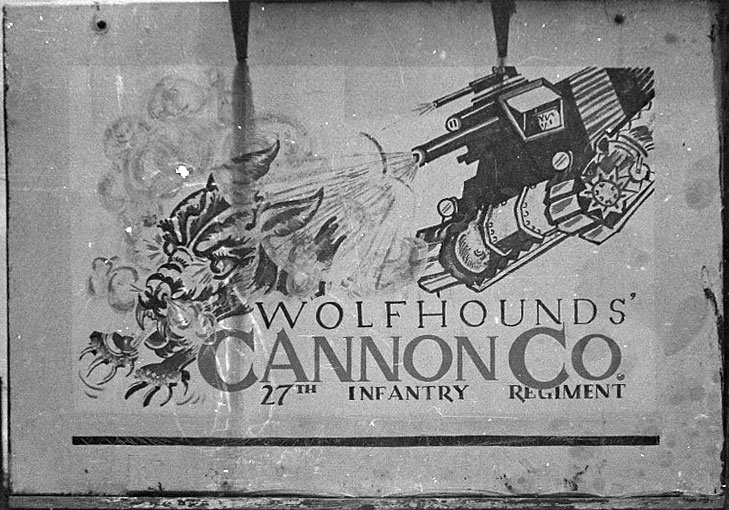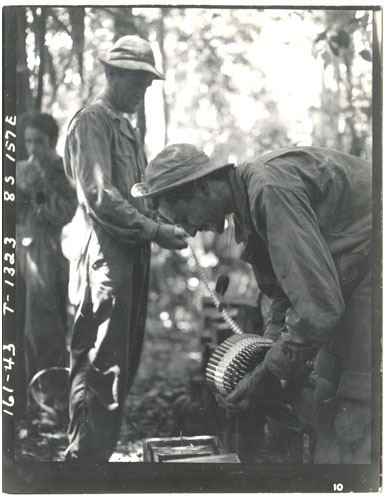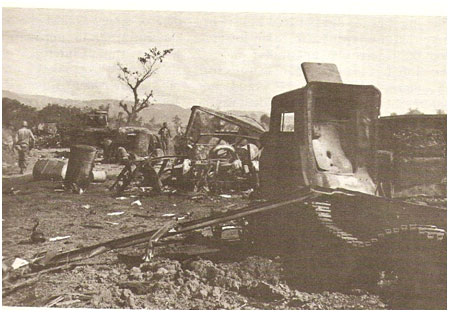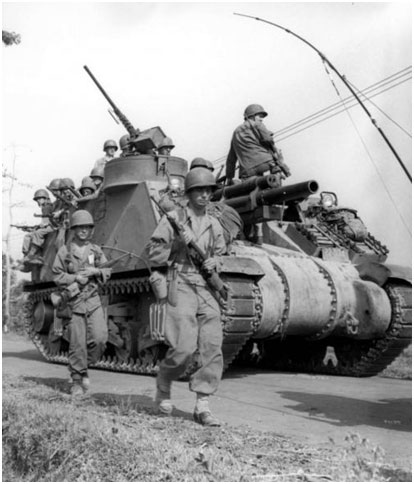Cannon Company: Blast from the Past
By Paul Maggioni
In August 1942 the Army changed its Tables of Organization and Equipment and added a battery of organic artillery to its infantry regiments. They designated this newly formed outfit “Cannon Company”. All regiments of the 25th Division, including the 27th Regiment—then training intensively in amphibious and jungle warfare on Oahu—formed Cannon Companies in accordance with this directive.

Theoretically the purpose of Cannon Company was to provide “close and continuous fire support to the regiment by destroying or neutralizing enemy troops that posed the greatest threat, and that could not be readily engaged by supporting artillery,” using towed 105mm howitzers. The concept may have been a good idea for combat in Europe, however, it would prove useless on the battlegrounds of the South Pacific, particularly since the 25th Division got shipped out to Guadalcanal before the Army could issue Cannon Company its cannon.
In addition to the absence of its primary weapons, the Wolfhound’s Cannon Company initially consisted of the dregs of the outfit. The novelist James Jones described the initial formation and human material of Cannon Company, 27th Infantry Regiment in his novel about Guadalcanal, The Thin Red Line:
[A] new company had been created in the Regiment. Existing first on paper as a directive from the War Department, and dreamed up for reasons largely technical and uninteresting to anyone not a student of tactics, this new unit was called the Cannon Company… and was to serve as a tiny artillery force within the Regiment…
Admirably conceived on paper, and existing only on paper, men were still needed to make Cannon Company an actuality. This was accomplished within the Regiment by a strange process which might well have been named “shunting the crud”… A Regimental memorandum was sent out ordering each company commander to donate a certain number of men. The commanders complied and the worst drunkards, worst homosexuals, and worst troublemakers all gathered together under one roof to form Cannon Company. This command was then given to the officer in the Regiment whom the Regimental Commander liked least.2
James Jones, The Thin Red Line
Landing on Guadalcanal in December 1942 and January 1943, the 27th Infantry Regiment spearheaded the XIV Corps January offensives, which eventually drove the Japanese off the island. Cannon Company found itself carrying rations, ammunition, and water up to the frontline and acting as stretcher bearers. Although Cannon Company did not give the regiment any added combat power, the manpower supplied by the cannonless Cannon Company likely proved crucial for hauling supplies to the front and the wounded to first aid stations.
Fighting ceased on Guadalcanal in February 1943 and the Wolfhounds rested for a short while, then resumed training on the island for a number of months. In August 1943 the 27th Regiment got shipped out to New Georgia island, where tough Japanese resistance drew in elements of four different US Army divisions. The 27th found itself once again pursuing beaten Japanese infantry, north across trackless jungle wastes of the unmapped interior of the island. Cannon Company once again served as supply mules—inglorious perhaps but absolutely necessary.

In October 1943 fighting ceased on New Georgia and the Wolfhounds found themselves at first in New Zealand, then the French island colony of Noumea along with the rest of the 25th Division. It was here in June 1944 that Cannon Company received their compliment of cannons—six brand-new self-propelled M7 Priests, a lightly armored 105mm gun platform with no turret and an open top.
The entire division spent an entire year on Noumea absorbing new recruits, testing new equipment and tactics, and conducting training intensive training exercises at all levels of command. During this period the regiment had time to build out Cannon Company with better quality personnel, experiment with tactics, and familiarize themselves with the concept. However, the Army had not furnished the Regimental Combat Teams documents on how exactly to use Cannon Company. There developed three divergent schools of thought about this within the Regiment: (1) the M7 should be used for indirect fire support; (2) the M7 should advance with the infantry and used like a tank; or (3) the M7 should be used as an assault gun against strong points, and as an anti-tank gun.
When the 27th Infantry Regiment landed on the Philippine main island of Luzon in January 1945, Cannon Company, driving its six powerful M7s, was now an integral part of the regiment’s combat power. The terrain of the Central Plains of Luzon proved excellent country for employment of Cannon Company. Unlike the swampy, tropical, and trackless jungle, one Cannon Company officer recalled, “The terrain was flat, open, and dry… There was an excellent road net and accurate maps and aerial photographs were available.”3 Thanks to better equipment, an increased understanding of tactical deployment, and more favorable terrain, Cannon Company would prove itself under fire in a bloody little battle at the hamlet of Pemienta weeks after landing in the Philippines. Upon landing on Luzon, according to Wesley Curtis, an officer serving in Cannon Company, “Cannon Company of the 27th Infantry was at full strength and all equipment and supplies were in excellent condition. Morale was high.”4
The 25th Division fought several vicious little engagements with the Japanese 2nd Tank Division on the central plains of Luzon. Driving ahead on one of the main east-west highways on the island, the First Battalion, 27th Regiment occupied the hamlet of Pemienta on the night of 29 January, accompanied by two Cannon Company M7s. The men had not yet fired a shot in anger with their mounted 105mm howitzers, “and the feeling was prevalent that finally we were getting close enough to the Japs to start shooting.”5 Unbeknownst to them, they had bottled up a column of Japanese tanks, artillery, and truck-borne infantry retreating west towards the town of Umingan.
The first Japanese tank sped right through the First Battalion perimeter. The infantry did not open fire as they thought it was one of the Cannon Company M7s! Moments after the first enemy tank passed through, a second tried the same trick. Sergeant John Charney’s M7 destroyed it with a single 105mm anti-tank round. This stopped the entire column of enemy vehicles, which trapped because the narrow road was surrounded on all sides by rice paddies. All Hell broke loose as the Japanese desperately tried to deploy under heavy American fire.
Meanwhile Regiment had contacted Cannon Company to move another two M7s into position to assist First Battalion. The small party of armored vehicles, moving along the moonlit road with no lights, came to a stream. The first M7 made it through, but the second stalled out. The first M7, thinking the second was following behind, continued on alone in the dark towards Pemienta. Before they got there a Japanese patrol ambushed the M7 with a magnetic mine, and killed or mortally wounded three of the crew with bayonets, while three of the crew escaped.
Back at Pemienta the First Battalion, thanks in part to Sergeant Charney’s M7, had stopped the Japanese column in its tracks. Cannon Company had drawn blood, and had bled at Pemienta.
Cannon Company would continue to contribute greatly to operations of the 27th Infantry Regiment throughout the remainder of the 25th Division’s role in the Luzon campaign through June 1945. Their M7s would be used both as artillery for indirect fire, and for direct fire support for advancing infantry.
Shortly after the war, the Army discontinued Cannon Company.

some destroyed by one of Cannon Company’s M7s. (Smith, “Triumph in the Philippines”)

1 Rush, Robert S. G.I.: The US Infantryman in World War II. Oxford: Osprey Publishing, Ltd., 2003, page 23.
2 Jones, James. The Thin Red Line. Although a work of fiction, Jones based nearly everything in his novel on actual personal experiences or impressions during his time with the 27th Regiment.
2 Curtis Wesley, The Operations of Cannon Company, 27th Infantry (25th Infantry Division) in Support of the 1st Battalion, 27th Infantry During an Engagement at Pemienta, 29-30 January 1945 (Luzon Campaign), Fort Benning Infantry School, page 5.
3 Ibid. page 7.
4 Ibid. page 7.
5 Ibid. pages 7-26.
